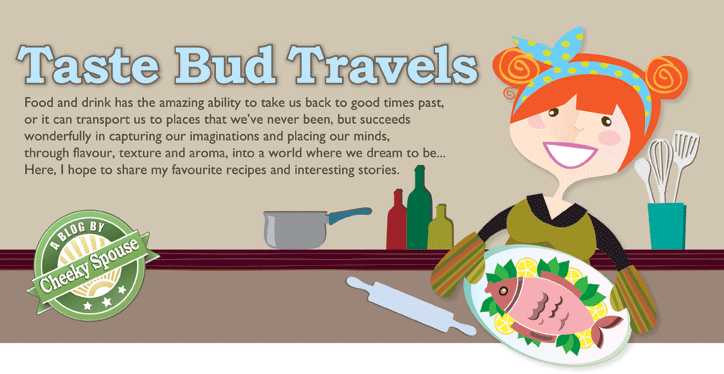I am pleased to offer three cookery books, hand selected by myself, from New Holland Publishers. With this special offer you can receive 20% of the normal price, plus you get free postage and packing.
To order your preferred book, simply click on the link at the end of each review to take you directly to New Holland's website, then enter the code
Cheeky1 at the checkout to qualify for the discount.
With Christmas just around the corner, what better time to buy a present for a foodie or even yourself!
The Billingsgate Market Cookbook
Think of fish and you'd probably immediately think of Billingsgate in London. Billingsgate is a heady mix of history, pride, hard work, tradition and camaraderie and The Billingsgate Market Cookbook is a celebration of all that is wonderful about fish.
Setting the scene through the market's rich and varied history, the people, and day to day activities, we are transported to the early hours of the morning as the market opens its doors. Bells ring and the trading begins as the porters trundle cart loads of fish quickly across the market floor.
The informative approach really helps us to understand where our fish comes from, there are comprehensive guides to the different species and a section on sustainability, all important these days.
This book should prove to be invaluable for those wanting to learn more,
or lose their fear of dealing with fish. From sourcing, storing to choosing and buying, through to preparation, everything is covered in a clear and approachable style which will have even the novice attempting the seemingly tricky parts of fish preparation. Step by step photographs take you through various skinning, scaling, steaking and filleting techniques. Dressing a crab is also a simple process when following the directions.
With 80 or so recipes covering white fish, flat and round, shellfish such as crabs molluscs and squid, coarse fish, like salmon, oily fish, smoked fish and exotic varieties, there is a wealth of inspiration.
The photographs of the dishes will have your mouth watering as you set off for the fishmongers, even the raw fish looks delectable with its shining scales and beady bright eyes.
All the recipes allow the fish to shine as the cooking is simple and unfussy, using only flavours that complement and enhance. John Dory with Lemon Thyme and Wild Mushrooms, Grilled Mackerel with Almond and Cranberry Glaze, and Roast Scallops with Leeks and Ginger are some of the enticing recipes to choose from and if you prefer something very traditional, then there's always White Fish in Beer Batter or Fish Pie.
This is the only fish cookery book you'll ever need.
Billingsgate Market Cookbook by C.J. Jackson
is published by New Holland Publishers, price £20.00.
Enter the discount code
Cheeky1 at the checkout for 20% off and free P&P.
Offer valid until 31st December 2010.
Made in Great Britain: Aiden Byrne
This is the book to own if you want to impress your dinner guests and are tempted to take your kitchen skills that little bit further.
Most people will have heard of Aiden Byrne, he has regularly appeared on the BBC's Great British Menu and he is also the youngest ever chef to win a Michelin Star at the age of 22.
This is an exciting cookbook that will take you out of the realms of home cooking and into restaurant standard food, where flavours and textures are elevated to a new level, however, the ingredients used are far from exotic as they reflect Aiden's passion for British cuisine using good British produce that's just on our doorstep.
Aiden's approach to food is creative but always pays the highest respect to the ingredients without stepping too far away from his British roots.
Each photograph showcases artfully presented dishes which display his passion and talent which is highly inspiring. Chicken Breast with Lemon, Rosemary and Figs, White Chocolate and White Truffle Risotto with
Pan-Fried Scallops, Veal Fillet with Lobster, Apple Fondant and Jabugo Ham and Warm Chestnut Cake with Chocolate Sorbet are all begging to made, no matter how complicated they may at first seem.
The recipes are interspersed with Aiden's authoritative views and advice on food and the accompanying photography shows him, sourcing ingredients from suppliers, working in the kitchen and even down on the farm and diving for his own scallops.
An ideal book for the more adventurous and competent cook.
Made in Great Britain by Aiden Byrne
is published by New Holland Publishers, price £12.99.
Enter the discount code Cheeky1 at the checkout for 20% off and free P&P.
Offer valid until 31st December 2010.
Danyel Couet's Paris
Paris is a city bursting with many cultures and therefore many cuisines and Danyel Couet, chef and restaurateur takes us on a journey to every ethnic quarter of the gastropolis. African, Arab, Jewish, Greek, Indian, and Asian recipes jostle for attention as if in the bustling city itself.
Danyel's, life-long passion for food started with simple French food in his grandmother's kitchen, this set him off on a gastronomical journey that led to him developing a love for couscous, strudel and Peking duck.
The gorgeous photography by David Loftus plants us right into the heart of a living breathing Paris, the atmosphere is almost pleasantly claustrophobic, comforting, exotic but somehow familiar and reassuring.
An array of cosmopolitan flavours are presented in over 90 recipes,
from Spice-Fried Cod with Coconut, Chilli and Lemon to Fried Eggs in
Ginger Stock, every aroma is sent to tantalise the reader. For those looking for more well known French bistro dishes there is Boeuf Bourgignon or Onion Soup.
Guaranteed to make you hungry to explore the Parisian global menu.
Paris by Danyel Couet
is published by New Holland Publishers, price £24.99.
Enter the discount code Cheeky1 at the checkout for 20% off and free P&P.
Offer valid until 31st December 2010.















































